Treatment of Varicose and Spider Veins
There are several surgical options for the treatment of varicose veins. Traditional ligation & stripping, PIN stripping, and ambulatory phlebectomy.
Traditional ligation & stripping of the great saphenous vein is usually performed in a hospital operating room or outpatient surgical center under general anesthesia. An incision is made in the groin and the saphenous vein is tied off at its origin. Then a series of incisions are made in the leg and a wire "stripper" is inserted into the abnormal veins, which are then pulled out.
Possible complications of vein stripping are damage to surrounding nerves leading to numbness, damage to lymphatic tissue leading to chronic leg swelling, and incision scars. Reaction to general anesthesia is an additional risk.
PIN stripping is an updated method of vein stripping. This technique is performed in a hospital operating room or outpatient surgical center but can be done using either general anesthesia or local anesthesia with IV sedation. A small incision is made in the leg and the "PIN stripper" is inserted and advanced through the vein. The tip of the PIN stripper is sewn to the end of the vein and as the PIN stripper is removed, the vein is pulled in on itself and is pulled out.
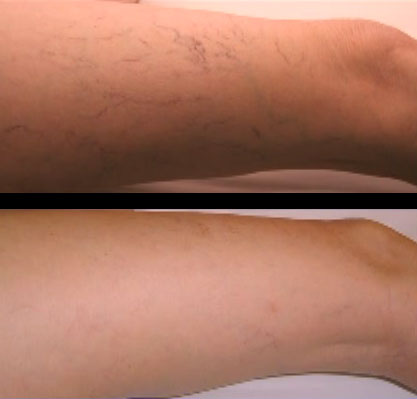
Before and After
Possible complications of PIN stripping are local numbness, incision scars, and allergic reaction to the local anesthetic (if used).
Ambulatory phlebectomy is usually performed in a doctor's office using local anesthesia. The area surrounding the varicose vein clusters is flooded with anesthetic fluid. A needle is then used to make a puncture next to the varicose vein and a small hook is inserted into the needle hole and the varicose vein is grasped and removed. Ambulatory phlebectomy is often performed in conjunction with minimally invasive endovenous catheter procedures or PIN stripping.
Possible complications of ambulatory phlebectomy are allergic reaction to the local anesthetic and local numbness.
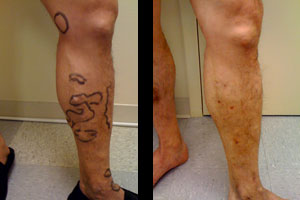 |
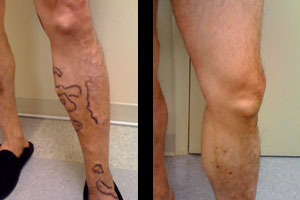 |
Before and 5-weeks post op

There are two types of endovenous procedures: endovenous laser treatment and endovenous radio frequency ablation.
Endovenous laser treatment is a minimally invasive, in-office treatment alternative to surgical stripping of the great saphenous vein. Instead of removing the saphenous vein, it is sealed closed in place. The skin on the inside of the knee is anesthetized and a laser fiber is inserted through a needle stick in to the saphenous vein. As the fiber is withdrawn, the laser is fired causing the vein to collapse and seal shut. Following the procedure, a compression stocking is worn for five days. Patients are able to walk immediately after the procedure and most individuals are able to return to work the next day. Endovenous laser treatment is FDA approved.
Possible complications of endovenous laser treatment are thermal skin burns and transient numbness.
Endovenous radio frequency ablation (Closure Procedure) is a minimally invasive, in-office treatment alternative to surgical stripping of the great saphenous vein. Instead of removing the saphenous vein, it is sealed closed in place. The skin on the inside of the knee is anesthetized and a radio frequency catheter is inserted in to the saphenous vein. As the catheter is withdrawn, heat causes the vein to collapse and seal shut. Following the procedure, a compression stocking is worn for five days. Patients are able to walk immediately after the procedure and most individuals are able to return to work the next day. Radio frequency ablation is FDA approved.
Possible complications of endovenous radio frequency ablation are thermal skin burns and transient numbness.
Ultrasound Guided Sclerotherapy is another office based treatment option to treat varicose veins which is often used in conjuction with another procedure. Ultrasound imaging is used to guide a needle into the abnormal vein and deliver medication to destroy the lining of the blood vessel and seal it shut. Ultrasound guided sclerotherapy is primarily used to treat large veins beneath the surface of the skin.
Possible complications of ultrasound guided sclerotherapy include: Inadvertent intra-arterial injection, skin ulceration, hyperpigmentation, telangiectatic matting, superficial phlebitis, deep vein thrombosis, and allergic reaction.
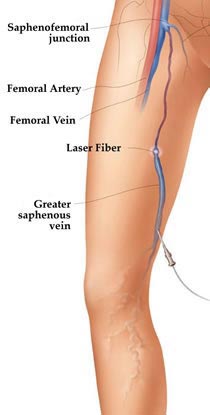
Laser and intense pulsed light (IPL) can be used to treat small spider veins and facial redness. Pulses of light energy are directed through the skin at the blood vessels. The hemoglobin in these vessels absorbs this energy in the form of heat and cauterizes the vessels closed.
Possible complications of light based treatments are skin burns, blistering, purpura (bruising), and scarring.
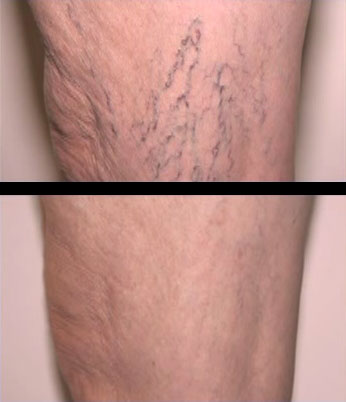
Laser Sclerotherapy
Before and After |

Laser Sclerotherapy
Before and After |

Laser Sclerotherapy
Before and After |
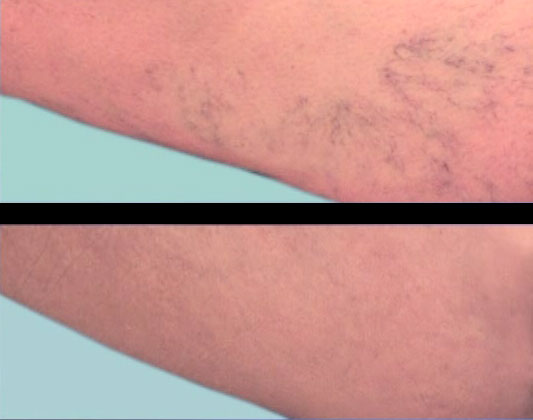
Laser Sclerotherapy
Before and After |

pressure to improve blood flow
Conservative treatments include compression stockings and herbal treatments.
Graduated compression stockings are a mainstay of initial/conservative management of venous disease. Graduated compression stockings are tighter around the foot and ankle and the compression decreases as it goes up the leg. This "graduated compression" promotes the normal flow of blood up the leg.
Possible complications of graduated compression stockings are obstruction of venous or arterial blood flow due to improper sizing or undiagnosed peripheral vascular disease.
In the area of herbal remedies, horse chestnut extract is the most commonly recommended herbal preparation for venous disease. Although there is no documented evidence of its efficacy, there are many anecdotal reports of beneficial effects on the symptoms of vein disease.